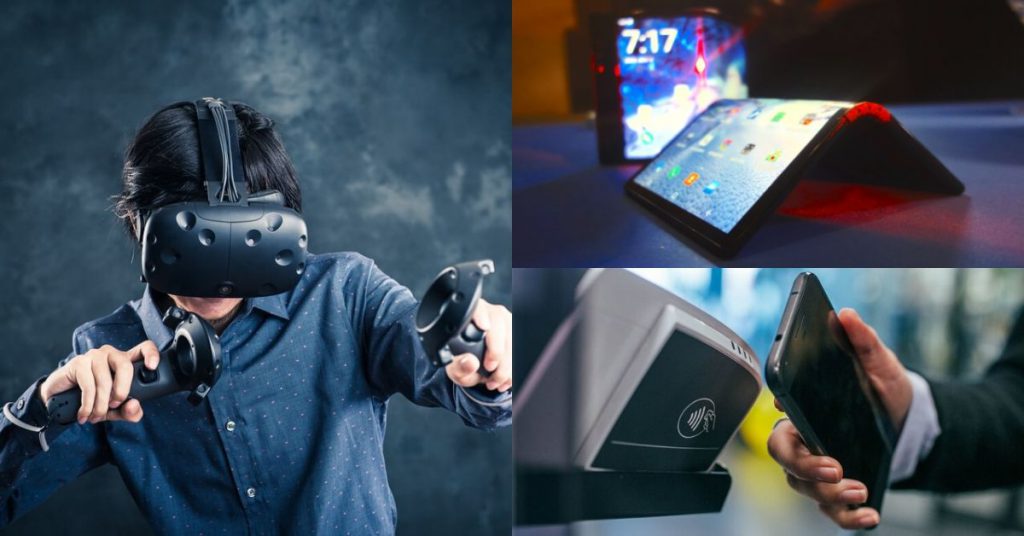Technology moves at an amazing pace, with plenty of new developments and changes in the landscape happening within the span of just one year.
With faster 5G speeds on the way that improve our connectivity even more as well as ever-competitive brands trying to get into our wallets with new product offerings, features and services, we have much to look forward to as we welcome the new year.
Looking ahead, we decided to try predicting what will happen in the world of consumer technology for the year 2020.
1. The Rise Of Foldable Phones
Foldable phones had a rocky start. Samsung’s Galaxy Fold had to be delayed back in April 2019, after early reviewers found that the screens broke in only a few days.
As if in response, Huawei delayed their own Mate X to conduct more tests on its viability.
Coupled with a hefty price tag and disastrous launches, there were many who thought that foldable devices would be dead on arrival.

But that hasn’t been the case.
Enough people are interested in rumours of Samsung Galaxy Fold 2 being in the works. Plus, Motorola’s own foldable Razr 2019 was reportedly delayed due to overwhelming demand.
Phones are no longer just a communication device, but a mobile platform for entertainment, gaming and work.
To fully enjoy all that, people want bigger displays without losing the devices’ portability, so folding up the device seemed like a simple way to get the best of both worlds.
So, I’m willing to bet that we’ll be seeing more foldable phone releases across various brands in 2020.
2. The Death Of Tablets (At Least Among Us Consumers)
Speaking of large displays, perhaps it’s time the tablet is put to rest.
It’s true that when Apple first released its iPad in 2010, it enjoyed some success, with some even considering tablets to be a laptop killer. It inspired many other companies to come up with their own tablets.
Fast forward to today and we can see tablets losing out to phones with increasingly large displays and laptops.
There are a few hanging on like Apple and Samsung, but we have also seen companies abandoning tablets.
For example, Google cancelled the production of 2 tablet devices in June 2019, to focus on its Pixelbook laptops.
There’s just not much demand for tablets anymore and we might finally see their final death throes in 2020, at least as a consumer product.

I say this as I still see (and have personally used) tablets as a point-of-sale device in retail. They are still convenient to install and use, so perhaps this is an indication that the tablet can still find new niches to fill.
3. An E-wallet Shakeup
I’m all for a cashless society, but there are just too many e-wallets. Having choices is good, but ultimately it is convenience and universal adoption that matters, and that means cutting the wheat from the chaff.
Right now, both local and foreign e-wallets are competing for a piece of the pie, and not all of them will be left standing once the dust settles.
As such, GrabPay, Touch n’ Go and Boost are emerging as clear leaders in Malaysia.
Smaller, niche players will find it hard to compete and may turn to mergers to survive, something that Axiata Digital Services Sdn Bhd CEO Khairil Abdullah believes is inevitable.
Much like Alipay’s dominance in China, someone will have to come out on top before we will have a universal cashless society.
4. More Video On Demand (VOD) TV Shows
Another battle will be taking place among streaming services. Once upon a time, our local broadcast stations and satellite TV providers like Astro dominated our TV time.
Not anymore. Netflix, HBO, AppleTV+, Disney+ and our local iflix, to name a few, have been moving into our living rooms with increasingly robust services and enticing packages.
“Ethics” aside (I’m referring to the recent Aflix controversy), 2020 will bring us a battle of these streaming giants as they all compete for our attention.

That can only be good news for us, as that would (hopefully) mean more and better content.
5. Making VR Gaming Great Again
A staple in many lists like this, but it was hardly the “next big thing” in consumer products that many lists touted it to be. We still don’t commonly see them in homes or even arcades, save for a few niche VR centres here and there.
What happened? Some will say that it is the high price tag, the lack of worthwhile games, or the shift from using VR tech as entertainment to more industrious uses such as in education and healthcare.
Regardless of the reason, one upcoming game may give VR entertainment much needed shot in the arm.
Back in 1998, the first Half-life was a game-changing (pardon the pun) video game that redefined the first-person shooter genre with its narrative scripted sequences, now a mainstay in many games of the genre.
Now, Valve is back with Half-life: Alyx, a VR exclusive game, slated to be released in March 2020.
The trailers look pretty good so far, much better than many of the games currently available on VR.
If Valve is able to do in 2020 what they did in 1998, we may see more AAA games being developed for VR systems, which in turn makes VR a relevant entertainment platform again.
6. The Dawn Of Cloud Gaming
One of the worst feelings as a gamer is not being able to play a game because your hardware can’t handle it.
That may be a thing of the past with cloud gaming. Using just an internet connection, you can now stream and play games regardless if your device has the ability to run those games.

It’s not that new of a concept; back in 2010, OnLive was the first major cloud gaming service, but due to how new the technology was coupled with less than ideal internet speeds, OnLive’s stint was shortlived.
Tech has come a long way since then, and the recently launched Google Stadia along with numerous other services is proof that cloud gaming is a viable model.
Sure, like any new service, it still has its problems, namely pricing, latency and the lack of an online community, but it now has a better shot than 10 years ago, especially with 5G on the way for many countries, like Malaysia.
7. The Foundations Of 5G Smart Cites
5G is said to be 100 times faster than 4G at 10 gigabits per second. It’s almost impossible to highlight all the changes that we may see as a result of this heightened connectivity.
As 5G is introduced to Malaysia, it’s safe to say that entire industries will be disrupted with the prospect of Malaysia having its own smart cities.

I know that isn’t exactly consumer technology, but the point I’m making is that 5G’s faster speeds will enable the development of better tech in a multitude of industries, which will affect our daily lives.
5G enabled smart city tech is already being tested in Langkawi, which includes 8K resolution streaming, parking systems and water management.
I myself drive through SS15 Subang Jaya’s pilot smart traffic lights on a regular basis. They use sensors rather than timers to control traffic and it already seemed to reduce congestion.
I expect to hear more about tech like this from both the government and private companies in support of the smart city concept.
- You can read more about what we’ve written on tech here.
Featured Image Credit: Tokyo Weekender, ExtremeTech, World Economic Forum














